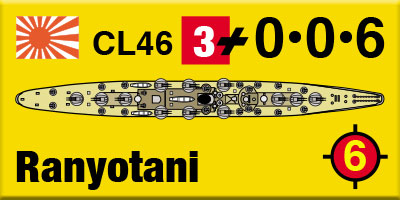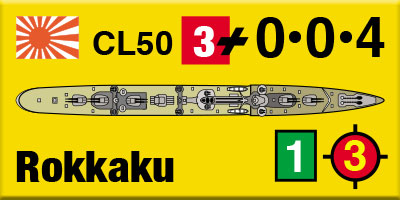The Emperor’s Sword:
First Look
by Mike Bennighof, Ph.D.
September 2023
 By 1944, the Japanese had no chance of winning naval battles (they never had a chance of winning the war itself). I wanted an opportunity to use the late-war Japanese ships and planes as something other than the object of American target practice, and crafted an alternative-history background that would allow that. That’s the background for Great Pacific War: Co-Prosperity Sphere, which posits a powerful Japanese Empire that can stand up to the Americans and fight for the Pacific Basin on an even basis (thus players win or lose the game by winning or losing the war on the battlefield rather than seeing Tokyo destroyed sooner or later than occurred in our actual history). The story line of Second World War at Sea: The Emperor's Sword takes place in that same background, titled The Long War (which it also shares with Plan Z). By 1944, the Japanese had no chance of winning naval battles (they never had a chance of winning the war itself). I wanted an opportunity to use the late-war Japanese ships and planes as something other than the object of American target practice, and crafted an alternative-history background that would allow that. That’s the background for Great Pacific War: Co-Prosperity Sphere, which posits a powerful Japanese Empire that can stand up to the Americans and fight for the Pacific Basin on an even basis (thus players win or lose the game by winning or losing the war on the battlefield rather than seeing Tokyo destroyed sooner or later than occurred in our actual history). The story line of Second World War at Sea: The Emperor's Sword takes place in that same background, titled The Long War (which it also shares with Plan Z).
The Emperor’s Sword is what we like to call a massive expansion set. In this case, that means 890 pieces (230 of those are double-sized) and a scenario book with thirty scenarios. Beyond that, it will also serve as a “toy box” for later expansions in The Long War and Second Great War story arcs. While it’s filled with new ships, we’ve taken care not to duplicate ships that will show up in late-war historical games like Philippine Sea.
So let’s talk about those toys.
The Japanese
The Imperial Japanese Navy is built around two large, expensive weapons systems: battleships and aircraft carriers. In our own history, Japan built two huge Yamato-class battleships, by far the largest such ships ever built. But the Imperial Navy planned to build five of them, and The Emperor’s Sword includes those other three ships.

Before settling on the Yamato design, the Imperial Navy studied a whole series of alternatives. We’ve given them four of those designs (assumed to have been built before Yamato and her sisters), with two examples of each. Two of these classes sport 410mm (16.1-inch) guns, and the other two the same 460mm (18.1-inch) guns that armed Yamato. And we also go beyond Yamato, with the next-generation super-battleships featuring 510mm (21-inch) guns.
Plus, the Japanese also field the fast battleships cancelled by the Washington naval agreements, the Tosa and Kii classes with 16-inch guns, and the never named Type 13 with 18-inch guns. Add to that the battleships already found in Midway Deluxe and South Pacific, and that is a vast array of heavy metal.
What they don’t receive are the Akagi-class battle cruisers, laid down but scrapped before completion. One of them, Akagi herself, would be completed as an aircraft carrier. In The Emperor’s Sword, the Japanese player has all four of them in aircraft carrier form. Those aren’t all of the new flattops: extra members of the Hiryu, Sory and Zuikaku classes, plus four huge Taiho-class super carriers, are added to the existing carriers of the First Air Fleet. It’s a formidable armada of sea-going airpower; in this reality, the Japanese do not settle for flimsy light carriers.

All of those carriers need lots of airplanes, and the Japanese decks are filled with third-generation carrier planes: the Mitsubishi A7M Reppu fighter, Aichi B7A Ryusei dive/torpedo bomber, Nakajima B6N Tenzan torpedo bomber and Yokosuka D4Y Suisei dive bomber now equip the Japanese carriers, with pilots equal in skill to those of the 1942 First Air Fleet.
The land-based air forces are re-equipped as well, with the jet fighters, jet attack planes, high-performance piston-engine fighters and long-range heavy bombers that either died on the drawing board or only saw limited use in reality.
To protect those carriers, the Japanese field the projected B64 and B65 battle cruisers and new cruisers and destroyers to escort them. A great many cruisers and destroyers.
The First Air Fleet gets more seaplane-carrying cruisers to help scout for all of those new carriers: two more Tone-class (as projected, but not built) and two improved versions (designed, but not ordered). And more heavy cruisers: four of the Ibuki class (one would be laid down, one ordered, and two projected) and two of the variant Ibuki design with extra-heavy torpedo armament. We also have the big and powerful 1941 Type A heavy cruiser, sketched but never ordered.

Light cruisers include four older ships that were ordered but cancelled, the rest of the projected Oyodo class fast cruisers (intended to serve as destroyer squadron flagships) and plenty of protection for those new carriers: a dozen large and 22 small anti-aircraft cruisers (again, ships designed but not completed).
We didn’t short the Emperor any destroyers, either: there are the sixteen Shimakaze-class super-destroyers, eight improved Yugumo-class and twenty improved Akizuki-class projected or begun, but never completed.
It’s a huge fleet. But the Americans can match it.
The Americans
The Emperor’s Sword is a Japanese-themed expansion set, and most of the new pieces are Japanese. The United States Navy managed to field far more of its planned ships and planes than did the Japanese, and most of those appear in our upcoming Philippine Sea game and its Leyte Gulf expansion. That still leaves plenty of additions.

The Americans receive the additional battleships, carriers and cruisers done in by Franklin Roosevelt’s questionable decision to pursue a balanced budget during the Great Depression. We’ve also added the Montana-class battleships, seen in the old Leyte Gulf, and the remainder of the Iowa class.
And as with the Japanese, we’ve taken the opportunity to look at some ships that were designed but not built, like the variants of the fast battleship North Carolina armed with 14-inch guns.

There’s also the projected “flight-deck cruiser,” a light cruiser with a flight deck. With plenty of aircraft carriers, there would have been no need to convert nine Cleveland-class cruisers into light carriers, so those appear here as cruisers.
The Story
The Emperor’s Sword is an expansion set for South Pacific and Midway Deluxe Edition. You’ll use the maps and pieces from those games, and add the huge stack of new ones to play the new scenarios.
The background story is the same as that in Co-Prosperity Sphere. Japan rules a massive, Pacific-spanning empire including the Kingdom of Hawaii. A large naval base in the Pearl River Estuary shelters a large fleet, and is the target of an American attack in December 1943. An American invasion follows, with a whole series of carrier battles as the Japanese contest the landings and follow-up convoys.

As Second Great War at Sea is a battleship-centered game in a world where fixed-wing development is somewhat limited, The Long War focuses on aircraft carriers and other cutting-edge technology. By the time the United States Navy developed tactics and doctrine for a carrier-based fleet, the Imperial Japanese Navy’s carrier force had lost its best ships, planes and pilots. In The Emperor’s Sword, you get to pit the best against the best.
That makes for a fun game. You need this set.
Click here to join the Gold Club
See your Gold Club Insider newsletter for ordering information.
Sign up for our newsletter right here. Your info will never be sold or transferred; we'll just use it to update you on new games and new offers.
Mike Bennighof is president of Avalanche Press and holds a doctorate in history from Emory University. A Fulbright Scholar and NASA Journalist in Space finalist, he has published a great many books, games and articles on historical subjects; people are saying that some of them are actually good.
He lives in Birmingham, Alabama with his wife and three children. He will never forget his Iron Dog, Leopold.
Want to keep Daily Content free of third-party ads? You can send us some love (and cash) through this link right here.
|
